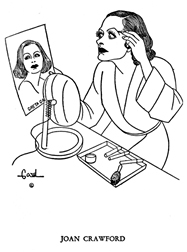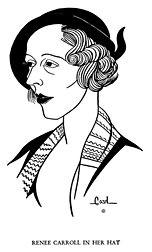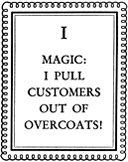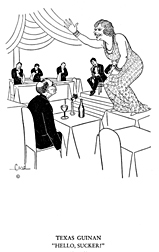Here’s Chapter 7 of In Your Hat, the 1933 tell-all memoir by Hat Check Girl to the Stars, Renee Carroll, in which she reflects on the early days of Sardi’s and how Vincent Sardi came to use the now-familiar caricatures of celebrities to garner attention for his eatery.

IT’S surprising what you can learn from hats. There’s something about the way a man wears one that betrays him instantly. He may smile and joke and think he’s fooling the world—but just by watching him when he saunters or hurries up to my window, I can tell him things that ought to get me a tabloid columnist’s job. I can tell when he’s out of work, and when he’s in the money. When he’s playing the market and winning—and when he’s losing. And there’s nothing pseudo-psychic about it! Just observation—and experience.
Take right at the moment when this ‘umble tome was being concocted. Broadway had been pretty hard hit, and there were hundreds of good actors as well as hams out of work. People who never tipped me less than a quarter before, now fumblingly left only dimes. And apologies were frequent, until I told the hardluckers that there were plenty in the same boat with them. Then, every once in a while, one of the new dime tippers would toss me a dollar bill and say nothing. I knew the answer. He’d landed a job! He was in the dough again.
But it wasn’t all so simple five years ago when I started on this job, the day that Sardi’s opened. I didn’t know a soul among the big-timers, could barely recognize a few of them. The job had been a sort of birthday present to me, and that first day I was awfully scared—and terribly anxious to succeed. I never dreamed that I’d stick at it five years—and then want to keep it fifty more!
Five years! It isn’t much when you say i fast—but a lot of things have happened since then. When Sardi’s opened, there weren’t any Broadway columnists, and a man’s biological secrets were his own. There weren’t any talkies, and the blonde and beautiful Tillie Awnertz could murder the king’s English without having to worry about losing her dear public. There weren’t even any nasal crooners—most of them were in college or short pants. Five years!
A lot of kids of my own generation were just getting their first foothold in show business and thought they were lucky to be able to afford Sardi’s eighty-five cent luncheon. Today some of them are way up on top and never dream of going upstairs for cheaper food, or even looking at the price list when they order their daily delicacies.
A Night in Spain was running at the Schubert Theatre just across the street, and Phil Baker, Ted Healy and Helen Kane were getting their first big chance. Today Baker and Healy are headliners, and Helen Kane has gained fame, fortune, notoriety and considerable poundage. She was getting fifty bucks a week then—now she gets over two thousand and works when she feels like it!
 Robert Montgomery was an adorable young juvenile who owed money to everyone in town and who frequently ate at Sardi’s on the cuff. He was trying frantically to woo and win the lovely Elizabeth Allen who was playing the lead in Broadway, but no one ever thought Bob would get her because it was doubtful if he could even pay for the license and ring. Today they’re happily married, Robert Montgomery is a screen name to conjure with, and his weekly pay check runs ever so high. And millions of movie fans find him every bit as charming as I did in the days “when.”
Robert Montgomery was an adorable young juvenile who owed money to everyone in town and who frequently ate at Sardi’s on the cuff. He was trying frantically to woo and win the lovely Elizabeth Allen who was playing the lead in Broadway, but no one ever thought Bob would get her because it was doubtful if he could even pay for the license and ring. Today they’re happily married, Robert Montgomery is a screen name to conjure with, and his weekly pay check runs ever so high. And millions of movie fans find him every bit as charming as I did in the days “when.”
Those first days at Sardi’s were a lot of fun—and a lot of worry too. There wasn’t a great amount of business, the restaurant was big, and the “nut” high. Like every café owner, Sardi wanted his establishment to be a rendezvous of-and-for celebrities. The little place near the Lambs Club had whetted his appetite for Big Names, and Sardi hungered to repeat his success on a larger scale.
We were talking about the disheartening business one day when things were particularly slack, and Sardi began to reminisce about famous Continental restaurants. Somehow the conversation swung around to Joe Zelli’s in Paris.
“Zelli’s is wonderful,” exclaimed Sardi. “No one would ever dream of seeing Paris without spending at least one evening in Zelli’s. It’s the rendezvous of all the celebrities. I guess they go there because their caricatures hang on the wall.
Read More »




